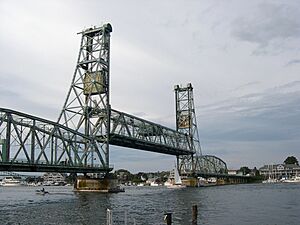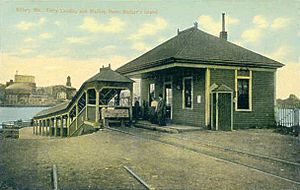Badger's Island facts for kids
Badger's Island is a small island in the Piscataqua River. It's located in Kittery, Maine, right across from Portsmouth, New Hampshire.
This island is important because U.S. Route 1 crosses it. This highway connects Maine and New Hampshire. You can reach the island from Kittery using the Badger's Island Bridge. The Memorial Bridge connects it to New Hampshire.
Today, Badger's Island is like a part of Portsmouth. It has many houses, condominiums, restaurants, and places for boats called marinas.
History
Shipbuilding Center
Before the Civil War, Badger's Island was famous for shipbuilding. Large eastern white pine trees were used for masts. Other lumber was used for hulls. This wood came down the Piscataqua River from forests inland.
The island was only about 322 meters from Portsmouth's busy docks. Its gentle slope into the deep river channel was perfect for launching ships.
The island was first called Rising Castle Island. Then it became Langdon's Island when John Langdon started his shipyard there. The first U. S. Navy ships ordered by the Continental Congress were built here. Master shipbuilder James Hackett built them. This included the USS Ranger in 1777.
One of James Hackett's apprentices was William Badger. He worked on the Ranger. In 1797, William Badger bought about 3 acres (12,000 m²) on the island. He became the main shipbuilder until he died in 1830. He launched over 100 ships. These included navy vessels, merchant vessels, and privateers.
Many great shipbuilders came from this area. William Badger's nephew, Samuel Badger, was one of them. But William Badger, known as Master Badger, is the most famous. He is buried on the island that now carries his name.
In 1837, Frederick Fernald bought Badger's shipyard. In 1844, he teamed up with William Pettigrew. They started Fernald & Pettigrew. This company built about 30 ships. They also built several clipper ships. One famous clipper was the Typhoon.
The Typhoon was launched in 1851. It set a sailing record to Liverpool, England. It took only 13 days and 10 hours from dock to dock. People called it the "Portsmouth Flyer." It was the largest merchant ship ever seen in that port at the time.
However, Badger's Island soon lost its importance for shipbuilding. The industry moved downriver to Fernald's Island. The Portsmouth Naval Shipyard had been there since 1800.
U.S. Navy vessels built on Badger's Island:
- 1776 — Raleigh - (22-gun Frigate)—shown on the Seal of New Hampshire
- 1777 — Ranger - (18-gun Sloop-of-war)—led by John Paul Jones
- 1782 — America - (74-gun Ship of the line)—given by Congress to Louis XVI of France
- 1791 — Scammel - (14-gun Schooner)—one of the first ten revenue service cutters
- 1797 — Crescent - (36-gun Frigate)—a gift ship for Algiers
- 1798 — Portsmouth - (24-gun Sloop-of-war)—paid for by the people of Portsmouth
- 1799 — Congress - (38-gun Frigate)—fought in the War of 1812
Clipper Ships built by Fernald & Pettigrew:
- 1851 -- Typhoon, 1,611 tons
- 1852 -- Red Rover, 1,021 tons
- 1852 -- Young Australia, 766 tons
- 1853 -- Water Witch, 1,204 tons
- 1853 -- Dashing Wave, 1180 tons
- 1854 -- Express, 1073 tons
- 1854 -- Midnight, 962 tons
- 1855 -- Noonday, 1189 tons
Ferry Terminus for Electric Railway
Badger's Island became a stop for the Kittery ferry. This ferry carried passengers across the fast-moving Piscataqua River from Portsmouth. It would arrive at a dock and waiting room on the island. This was for the Portsmouth, Kittery & York Street Railway.
Starting in 1897, this company ran trolleys. They went through Kittery Point and across the salt marshes of Brave Boat Harbor. The trolleys then went to York Harbor and York Beach, which were popular summer resorts.
In November 1901, this trolley line became part of the Portsmouth, Dover and York Street Railway. The trolley service continued until 1923. That's when the Memorial Bridge opened. This was the first bridge over the river that did not charge a toll.
The section of U.S. Route 1 across the Badger's Island Bridge was part of a special plan. It led to Kittery's John Paul Jones Memorial Park. This park has the Sailors' and Soldiers' Monument by Bashka Paeff. This whole area was designed as a "City Beautiful" project to go well with the new Memorial Bridge.





